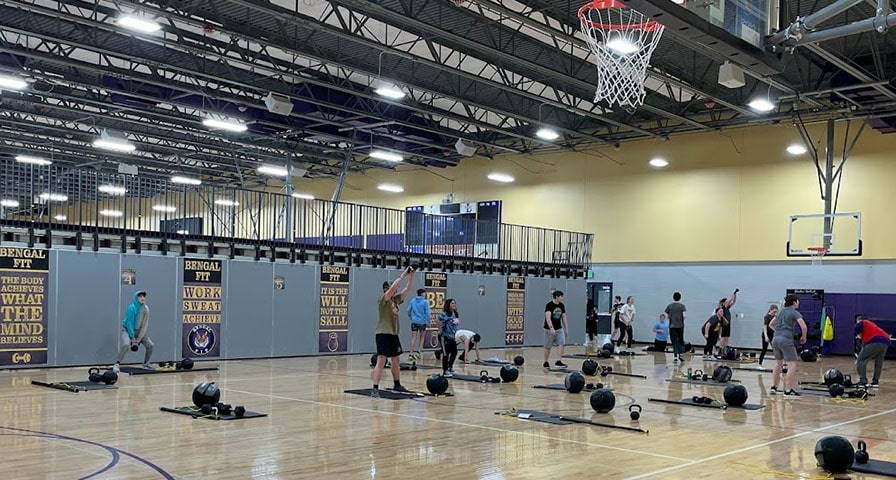
New Class Offerings and IHT ZONE Heart Rate Monitors Drive Students to Meet Today’s Goals While Building Lifetime Fitness Habits
When a community bond paved the way for a new high school building in Lewiston, ID., Chris Meyer saw an opportunity to recreate the school’s physical education program with new class offerings and heart rate technology that introduced students to fitness techniques they can use as adults.
“We had a really solid PE program, we felt, but we wanted to take it to the next level,” Meyer said. “That’s been the challenge I have given my department, going to that next level. What does that look like?”
For Meyer and the PE team at Lewiston High School, that ‘next level’ vision included implementing the Comprehensive School Physical Activity Program model. With a strong program in place, they evaluated their program and set goals to implement fitness technology (including heart rate monitors), expand opportunities for physical activity during school, and improve family, community and staff involvement.
In redesigning the curriculum, the team merged specialized classes where students focus on different elements of fitness with heart rate monitors to help them track their activity and maximize the time they spend in class. At the time, the newest member of the teaching team — 2012 National Middle School PE Teacher of the Year Jessica Shawley — had experience with IHT ZONE heart rate monitors.
Expanding Course Offerings to Appeal to More Students
Meyer and her team began implementing their vision by revamping their curriculum to include classes titled:
- Total Fitness Foundations
- Lifetime Fitness
- Dance-Yoga Fitness and
- Elite Fitness
While students took part in the new classes, Shawley helped Meyer apply for grants that might provide funding to purchase heart rate monitors. They learned in the summer of 2020 that their application to the Lewis & Clark Valley Healthcare Foundation had been approved, and when students returned to campus following months away due to COVID’s initial shutdown, the teachers introduced the IHT ZONE heart rate monitors, first in Meyer’s Elite Fitness class and Shawley’s Dance-Yoga classes.
“Counting the three months of summer break, our students were out of the classroom for six months and our fitness test scores definitely took a hit,” Meyer said. “I think having the heart rate monitors at that time helped students realize how their fitness was affected.”
As a new year began, most returning students were eager to get the heart rate monitors back on during class and the incoming ninth-graders adapted quickly to their new PE routine.
Students in the Elite Fitness class have worn the heart rate monitors from day one. They had previous experience with them in their Total Fitness Foundations class and hit the ground running.
“Students look forward to wearing them and they understand how they work and what we are tracking,” Meyer said. “They understand where their heart rate should be depending on whether it’s an anaerobic or an aerobic workout and how long they should be in each heart rate zone depending on the type of workout we are doing. They understand the colors and where they should be.”
For classes where she’s introducing the heart rate monitors for the first time, Meyer spent up to 3 class sessions explaining the technology and how to interpret the real-time feedback. Students grasp the concepts quickly and after just 1-2 classes, after which they can have more meaningful conversations about the intensity with which they exercise.
“We’ll have conversations about how this is part of student assessment for the day,” Meyer said. “It’s a great teaching tool that way. The students who are there to learn and be present during the workout, they ask good questions.”
Early in the year, and especially with students new to the IHT ZONE, Meyer focuses on the choices students are making during their available workout time. She shows each student their progress at the end of class and they see on her computer screen whether they met their goal for minutes of moderate to vigorous exercise or not.
“The heart rate monitors add accountability,” Meyer said. “I love that they can see the goal when they scan their heart rate monitors in. It’s a great tool to talk to them about their workout, ‘okay, last class what did you do and how did you feel and what can you do differently today?’”
Allowing Students to Find Early Success
The heart rate monitor gives students who previously may have had a rough time in PE class a chance to succeed and develop habits that can become a long-term fitness solution.
“I have a student in my Elite Fitness class who started the semester very unfit,” Meyer said. “The heart rate monitors allow me to show her how every activity she participates in relates to the heart rate zones and where she needs to be. During our fitness training, she instantly shoots up to red. So I can tell her she can dial it back a bit to stay in that cardio zone.
“It’s an excellent teaching tool for a student such as that because she has a visual right there on her wrist to know when to try to drop out of the red,” Meyer said. “Walk a few steps, go walk a lap if you need to, to bring your heart rate back down.”
It works for students who have opted to take Meyer’s Elite Fitness class as an elective multiple times. The class models itself after a CrossFit gym with different types of equipment.
“We created a portable CrossFit gym in one of our auxiliary gyms and students like that,” Meyer said. “One young man really gets it. He’s increased the amount of weight he can lift and he is eager to see where his heart rate is in every workout. I am starting to see that growth in repeat students.”
Growing into a Model PE Program
The new PE curriculum and the heart rate monitors have Lewiston’s program moving in a positive direction, one Meyer hopes other districts in the state see and want to emulate.
“We really do feel like we have a model physical education program or are certainly building one in the state of Idaho,” Meyer said.
As her students become more familiar with the heart rate monitors, Meyer and her team will encourage them to get further in depth with the data.
“That’s the next-level goal for us,” Meyer said, “to see how they are using the data and ask what they are learning from it.”
Students receive a heart rate report following every class via email. They can reflect on the session by replying to the email or by completing an assignment that the teachers assign through Google Classroom. Using the data, students can give the teachers vital feedback on things including:
- What types of questions students are asking
- Which types of workouts help more students meet their goal
- How students are trending with their fitness, either through minutes of MVPA or fitness test results
“We haven’t had students look back at the data nearly as much as we should,” Meyer said. “That’s something we can definitely do to use the monitors better.”
Tapping into Grant Sources Including the Local Healthcare Foundation
While the bond for the new high school – which would incorporate 9th graders as well as the 10-12 graders – covered construction and basics, it didn’t include funding for equipment beyond desks and chairs. Fortunately for Meyer, Shawley had experience with both the IHT ZONE heart rate monitors and grant writing. Together, Meyer and Shawley applied for a handful of grants and received most of them.
“We went to work writing grants,” Meyer said. “We wrote a lot of grants. We were very fortunate to receive several of them and that’s what allowed us to purchase the heart rate monitors along with fitness curriculum and fitness equipment.”
The two largest grant awards came from the Lewis & Clark Valley Healthcare Foundation, a fund developed when the local hospital changed ownership and the Idaho Office of Drug Policy Substance Abuse Block Grant.
They used the first $10,000 grant on IHT ZONE heart rate monitors and the second on iPads for students to use in their PE classes. When the teachers received their first $10,000 grant, the local school district provided several laptop computers that Meyer and her teaching team could use to run the heart rate monitors during classes.
“The LC Valley Healthcare Grant and the Idaho Office of Drug Policy Grant have been very generous to us,” Meyer said. “We received several other regional grants that provided significant funding, but they were the ones that made our IHT ZONE heart rate monitors and our CrossFit style fitness gym happen.”
The grant funding and community partnerships enabled Meyer and her team to expand before- and after-school fitness opportunities for students. Funding provided staffing for an after-school fitness program and outdoor table tennis. Community partnerships have been expanded to include western swing dance classes and the school’s annual Bengal Fit Games.
“We have also grown our family involvement by sharing a newsletter with information about our fitness opportunities and IHT ZONE heart rate monitors,” Meyer said.
With grant funding and teamwork, Meyer’s team built a quality Comprehensive School Physical Activity Program with IHT ZONE heart rate monitors providing quality assessment data.
Boost Student Wellness with the Spirit heart rate monitors




